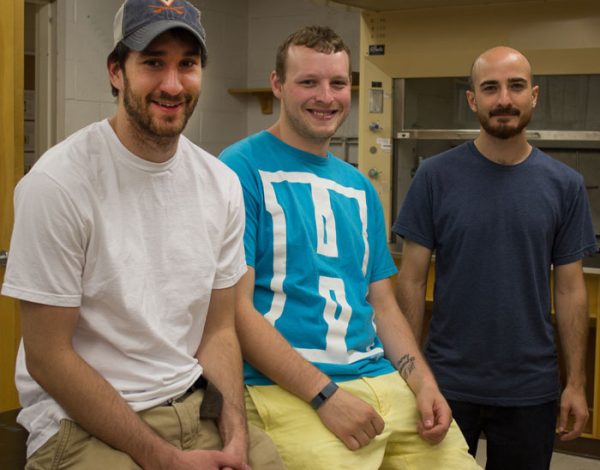Thomas D. Walsh Graduate Research Fellowship Competition – Academic Year 2014/2015

The Thomas D. Walsh Graduate Research Fellowship, made possible by the generous support of Dr. Thomas D. Walsh, recognizes outstanding contributions by M.S. candidates to graduate research. Returning graduate students are eligible for this prestigious award after their first year. The Thomas D. Walsh Graduate Research Fellowship supports the winner with a research assistantship and tuition support through their second year.
During the last application cycle the graduate committee narrowed the applicant pool to three finalists: David Lee, Casey Oian, and Phillip Scott. A brief biographical sketch and research abstract summarize each finalist’s strong application. The award winner will be announced during the reception for new graduate students on Friday, August 15.
David Lee graduated from UNC Charlotte in 2013 with a BS in chemistry. He is currently pursuing an M.S. degree in chemistry under the direction of Dr. T. Schmedake with whom he had carried out undergraduate research. Upon completing his Master’s degree at UNC Charlotte, David plans to continue his career as a Ph.D. graduate student.
David’s research is focused on the development of improved hole transport materials (HTM) for electronic devices. Thin-film, solution-processed solar cells offer the promise of inexpensive, lightweight, large area and flexible devices which can help meet global energy needs in the 21st century. However the issue of achieving the necessary performance and stability has limited the commercial viability of such devices. To meet these challenges, the development of new and improved materials is critical. In this context, the goal of the research is to synthesize novel HTMs based on the popular spiro-OMeTAD, which is still regarded as the gold standard for HTMs over 15 years since it was first reported in 1998 by Grätzel and Bach. Spiro-OMeTAD has been used in dye sensitized solar cell type architectures where its favorable HOMO level, pore infiltration ability, and morphological stability have made it the HTM of choice. It has also been used in planar heterojunction devices, achieving over 15% power conversion efficiency using a perovskite absorbing layer. Modified spiro-OMeTADs will be synthesized and characterized to determine their film properties and hole conductivity.
Casey Oian attended the University of North Dakota and received a B.S. in Chemistry. There, he worked on a variety of projects, such as the capture and polymerization of carbon dioxide from flue gas streams or the synthesis and characterization of cyclodiphosphazanes and their reactivity with group 4 transition metals. After completing his Master’s degree at UNC Charlotte, Casey plans to attend a Ph.D. program and conduct research in the area of catalysis and polymer synthesis.
At UNC Charlotte Casey joined the research group of Dr. D. Rabinovich and is currently working on pyridine and heterocyclic thione derivatives, which represent some of the most common nitrogen- and sulfur-donor ligands. However, the coordination chemistry of simple bidentate ligands containing both donor groups remains chiefly unexplored. His research is focused on the synthesis and reactivity of the first examples of molybdenum(0), manganese(I) and rhenium(I) complexes supported by N,S mixed-donor ligands. More specifically, Casey’s research is expected to outline the preparation, complete characterization, and preliminary reactivity studies of complexes such as LMo(CO)4 and LM(CO)3Br (M = Mn, Re), where L is a pyridine/thione mixed-donor ligand.
Phillip Scott attended the University of Virginia, where he graduated in 2013 with a B.S. in Chemistry (Biochemistry Specialization) and a B.A. in Biology. At this institution he also gained his first undergraduate research experience. Furthermore, he has worked as a research and development intern in industry (Inorganic Ventures; Blacksburg, VA). Philip’s goal is to continue his graduate education in a Ph.D. program, and to eventually work for a medical research institution.
Currently, he works in the laboratory of Dr. J. Troutman, which focuses on the biosynthesis of bacterial capsular- and exo-polysachharides, representing critical components to microbial interactions with mammalian hosts. These bacterial sugar polymers are constructed upon the C55 isoprenoid anchor, bactoprenyl phosphate. The lab has developed fluorescent analogues of bactoprenyl phosphate that allow for sensitive detection of polysaccharide precursors and are therefore very effective probes for proteins involved in bacterial polysaccharide biosynthesis. The Troutman group is currently utilizing these probes to study the capsular polysaccharide biosynthetic pathways to Capsular Polysaccharide A and B of Bacteroides fragilis, which are important in abscess formation induced by this organism, as well as symbiotic interactions with a mammalian host. Other polysaccharide biosynthesis pathways are also being studied from the human pathogen Vibrio vulnificus and typically benign but opportunistic pathogen Escherichia coli.
Phillip’s work focuses on the biosynthetic enzymes responsible for manufacturing Colanic Acid, a repeating six-sugar bacterial exopolysaccharide that helps protect E. coli from stomach acid. The goal of this project is two-fold: functionally characterize the enzymes responsible for the synthesis of colanic acid and develop a new multi-functional probe for characterizing the biosynthetic pathway to colanic acid. Extensive biochemical work including molecular biology, protein expression and purification is required to study each individual biosynthetic reaction in colanic acid production. The multifunctional probe is manufactured chemoenzymatically, requiring a combination of organic synthesis and enzymatic reactions. Phillip is developing an azido geranyl diphosphate analogue (GPP) that serves along with isopentenyl diphosphate (IPP) as a substrate for Undecaprenyl Pyrophosphate Synthase (UPPS). This enzyme elongates the azido-GPP analogue through condensation reactions with IPP to form the full-length azido-bactoprenyl analogue. The azide moiety can undergo a 1,3-dipolar cycloaddition with terminal alkynes. Therefore, he plans to develop a multi-functional compound with tailored applications that are dependant upon which molecules are attached to the azide.